How The Bass Changes Your Chords
Let's start with a simple example.
Here I'm moving the same shape on the 2nd, 3rd and 4th strings between two positions...
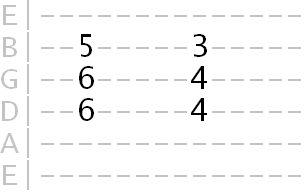
You'll probably associate these shapes with the root bass on the 5th string, giving us two minor chords, C sharp minor and B minor...
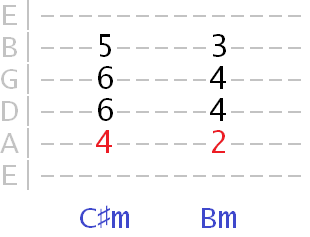
But now take a listen to how the voicing of these shapes changes with a different bass root...
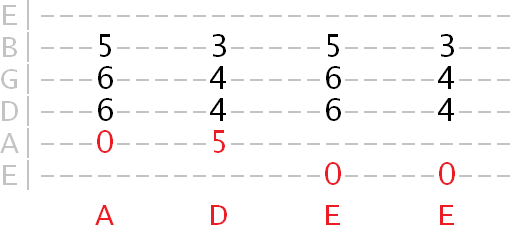
We're technically no longer playing C♯m and Bm, even though we can recognise what we're playing as part of those shapes.
Let's break down what's going on here.
Minor Triad in Major 7th Chords
We started on a shape that would be associated with a minor triad, if the root was in its familiar position.

However, if we move the bass root down two whole steps, that minor triad becomes a major 7th chord. In other words, the bass defines the chord quality...

So in this example, C♯m becomes Amaj7, using exactly the same triad form.
This is because these two chords share the same notes. You could also see C♯m as containing the major 3rd, 5th and major 7th intervals of Amaj7.

This means one way we can harmonise Amaj7 is to play a C sharp minor triad anywhere on the neck.
Below I'm using four-string shapes. In the audio clip, the first sequence is with a C♯ bass (C♯m), the second with an A bass (Amaj7)...
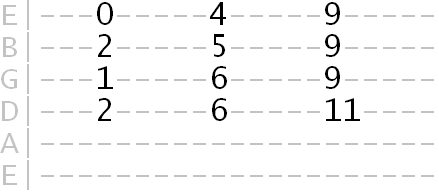
So the major 7th chord can be seen as a specific inversion of a related minor triad...

And this relative positioning doesn't just work with triad shapes. We can also play scales in these relative positions.
Take Gmaj7, which, using what we've learned, is relative to Bm. Therefore, we could play B minor pentatonic, including all the licks we know for this scale, over G major or Gmaj7 to get that major 7th sound in our lead...

And of course, where there's a chord, there's an arpeggio. So we can use a minor arpeggio to give any major chord a major 7th colour.
Here I'm playing a C sharp minor arpeggio over A major...
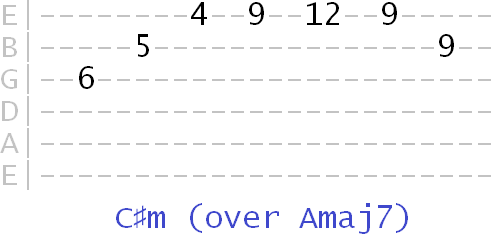
The general concept we're moving towards here is that you can use triads, scales and arpeggios in relative positions to the chords or bass you're playing over to colour your music in different ways.
Major Triad in Minor 7th Chords
Another example of this concept. Here I'm playing a D major triad...
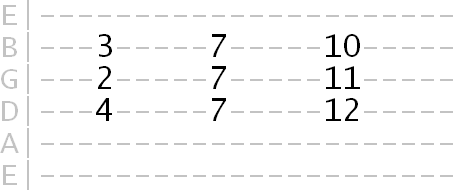
But hear how this changes when the bass is on B...
We now get a Bm7 chord.
So there's a relationship of shared notes between D major and Bm7.
The D major triad gives us the minor 3rd, 5th and minor 7th of Bm7...

As you can see, there's a minor 3rd interval between the relative bass positions of Bm and Dmaj...

The table below shows which major triad we would play to get the relative minor 7th on other roots...

We can also use this relative major/minor concept to interchange between major and minor.
For example, here I start on A major. Move the triad shape up 3 frets (or a minor 3rd) and we get Am7...

This kind of major/minor interchange is useful when playing over power chords, which are major/minor neutral, or simply a bass note.
Just like before, we can also use the relative triad as an arpeggio. So over Gm, for example, we could play a Bb major arpeggio to get the Gm7 sound. Because there's no G root in there, it has a more open sound...

The table below shows examples of which relative major triad we would use over a minor chord to create the minor 7th sound...

So those are just two basic examples of using triads in relative positions to the root bass or chord to create different chord colours. You can use them to give your harmonies and melodies more mileage.
Let's try a slightly more complex example...
Major 9th
Here I'm playing an E major triad across the neck using simple 3-string shapes...
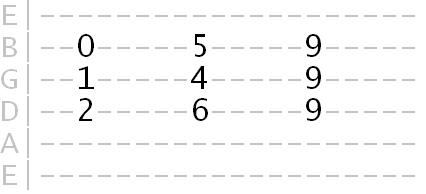
Now listen to how the sound of this shape changes when we play it over A major.
Over A, the intervals of E major become 5, 7 and 9...

So if we play this E major triad over an A major chord, we get the combined intervals that make up a major 9th chord. Amaj9 in this example.
To help you visualise this relationship, you can see the E root of the triad we're playing as a 5th interval above the bass root, or the chord we're playing over, A or A major in this case.

We could do a similar thing over G major, for example.
D is a 5th above G. So try playing D major over the G, whether as a chord or an arpeggio...
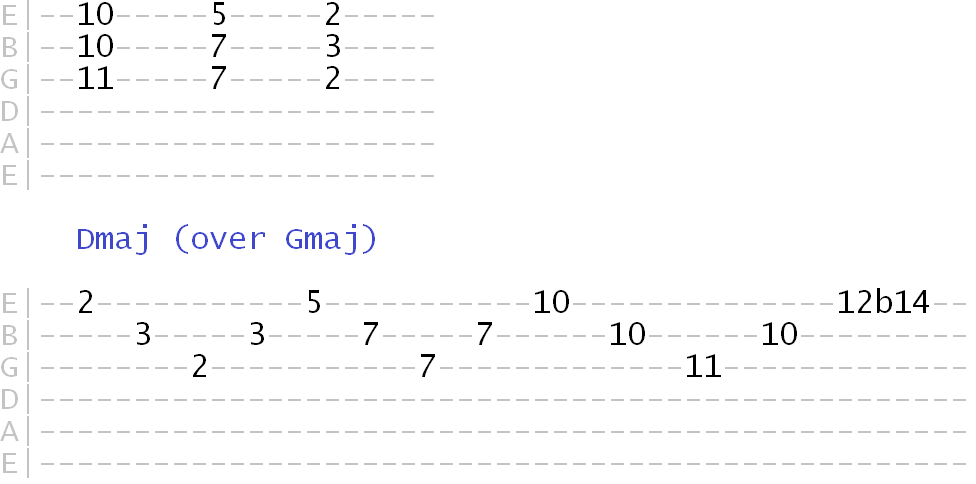
Minor 9th
Here's another example of creating an extended chord voicing from a relative triad position.
Here I'm playing a regular B minor triad...
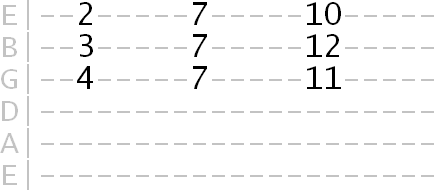
Now let's hear this played over an E minor chord.
Playing this B minor triad adds the intervals of a ♭7 and 9 to the E minor triad, giving us a minor 9th chord. Em9 in this case.

And just like the previous example, the triad we're playing can be seen as rooted a 5th above the backing chord.

So we effectively have two triad forms, E minor and B minor, that we can interchange over E minor, such as with this arpeggio example...

In that example, I started with a B minor arpeggio, and then moved seamlessly into an E minor arpeggio. To the listener, it just sounds like an extension of E minor.
Let's look at one final example...
Dominant 9th
Here I've laid out a B♭ minor triad on the top 3 strings...
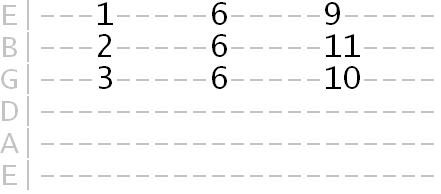
Now let's hear it over an E♭ major chord...
The B♭ minor triad has added a ♭7 and 9 to E♭ major, giving us a dominant 9th flavour (E♭9 in this case)...

Conveniently, we can use the same interval relationship as the two previous examples to find our relative triad. B♭ is a 5th interval from E♭...

And like before, we can use this relative triad as an arpeggio to colour the major or dominant 7th chord.
Here, I'm starting with an E♭ major arpeggio, moving into B♭ minor, before ending on E♭ major again. Again, what we hear is an extension of the chord we're playing over...

In Summary...
So the general concept here, is that we're using those familiar major and minor triads in relative positions to the chord or bass we're playing over.
The below table shows an overview of the relationships we've explored relating to Cmaj and Am...
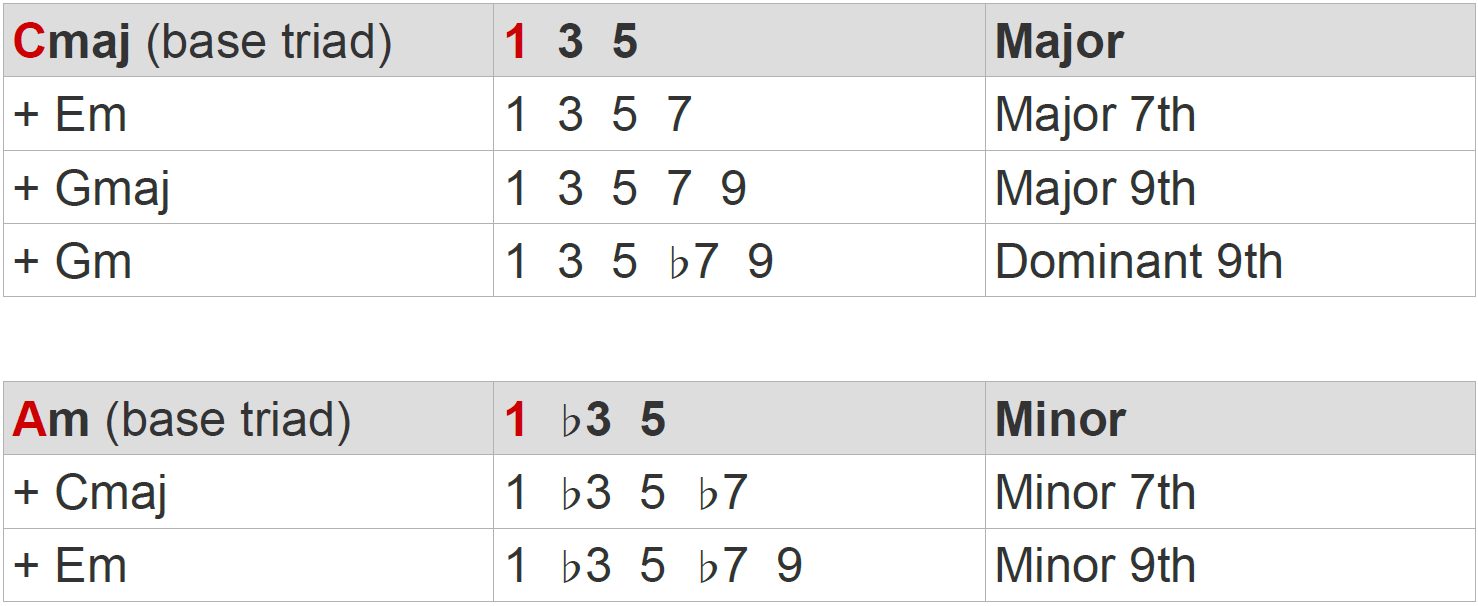
We can extend the chord being played, both harmonically and melodically, using those familiar triad shapes and patterns.
By combining them with the triad being played on the root, you can lay the foundations for more complex and flowing harmonies and melodies, something we'll be sure to explore further in future lessons.
You can learn more about the power of knowing triads, including access to chord tracks on all roots to help you explore what we've learned, in my Chord Connections course.

